< more recent | 22-30 September 2022 | older >
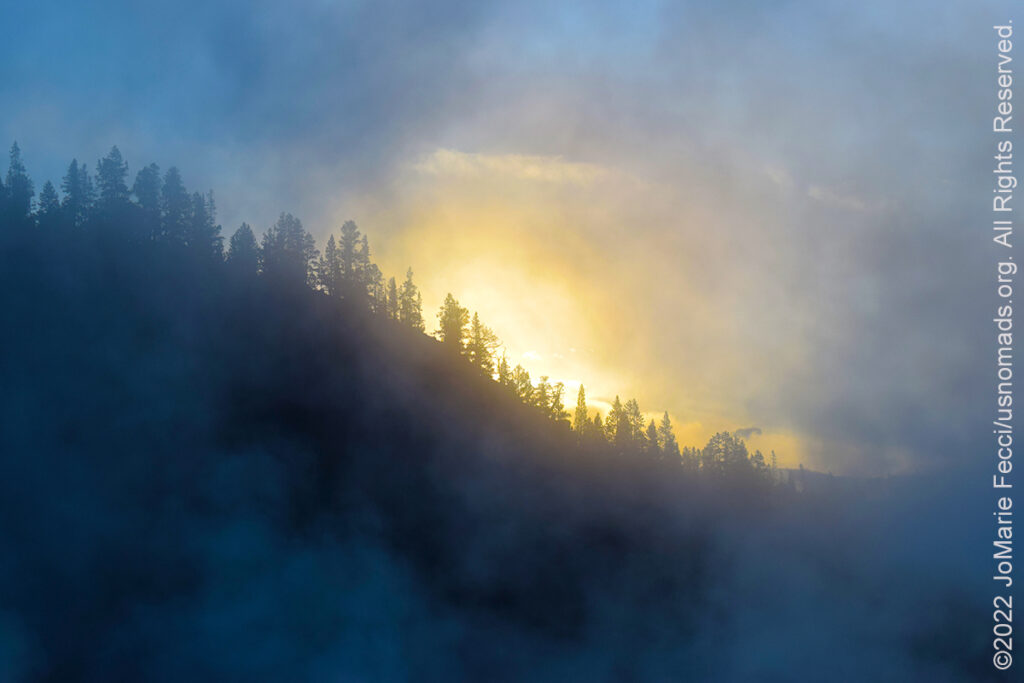
30 September 2022: It was really cold last night and in the morning I woke up really early feeling frozen and bundled myself into the Jeep at first light. Today the focus was on exploring some of the other-worldly landscapes created by the strange steam vents and geysers and other odd water-features and geological oddities that Yellowstone is famous for. Headed for the Grand Prismatic Spring while the entire landscape was enveloped in a combination of fog and steam that made it even more “otherworldly” than usual…
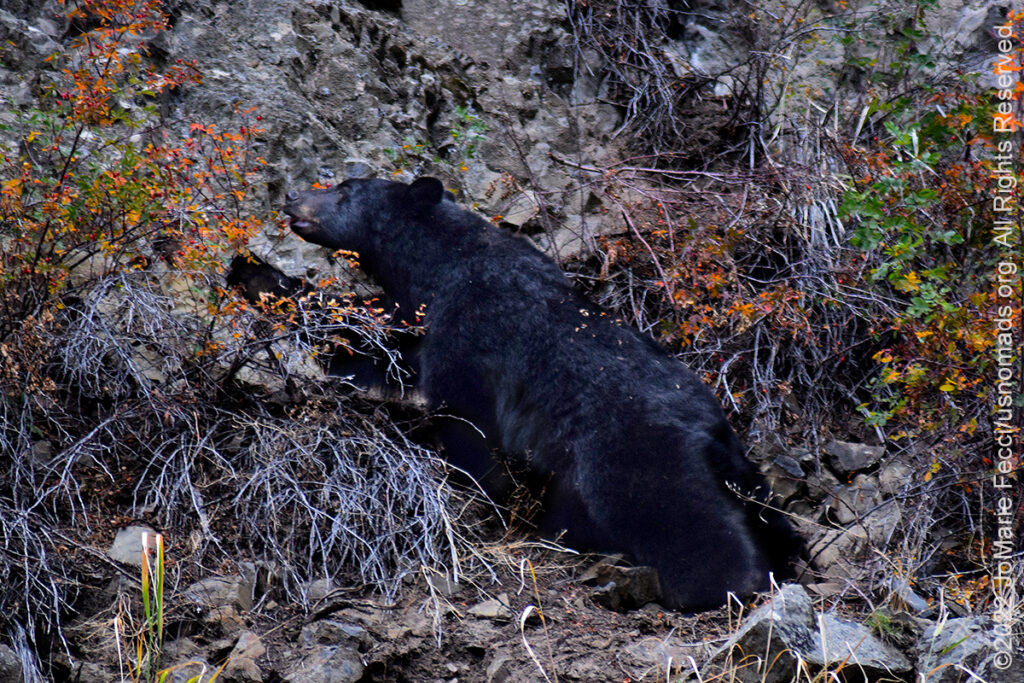
29 September 2022: Went looking for wildlife today, heading north to the Lamar Valley, even though most of the road into that area was still closed due to the flooding last summer. I went as far as I could go, then turned west to Mammoth Hot Spring Terraces. I did see quite a lot of buffalo (from a distance) and a few elk but the “coolest” sighting of the day was a big bear eating berries in the brush …
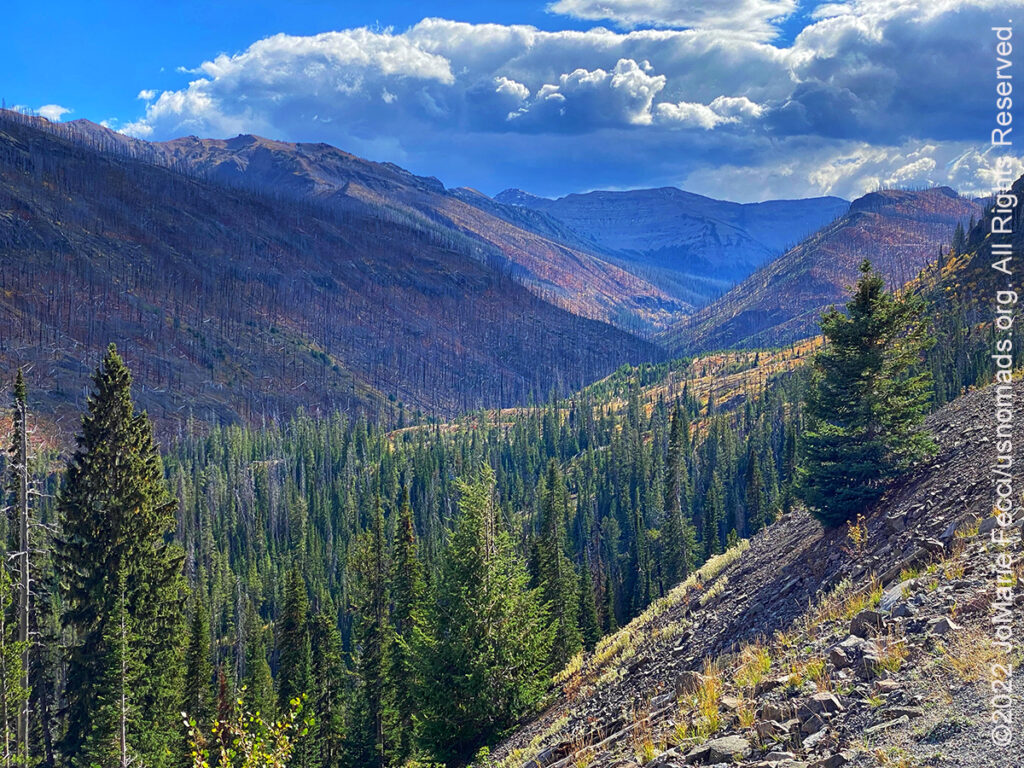
28 September 2022: Broke camp in the morning and decided to see if I could have better luck seeing and possibly photographing the horses. I was able to get much closer and make some photos, though the horses were just grazing mellow-like and the images are not incredible. Still, it was getting to see them and share the space with them in this wild place that was so special. From there I picked up the route into Yellowstone National Park, where I set up basecamp for the next few days…
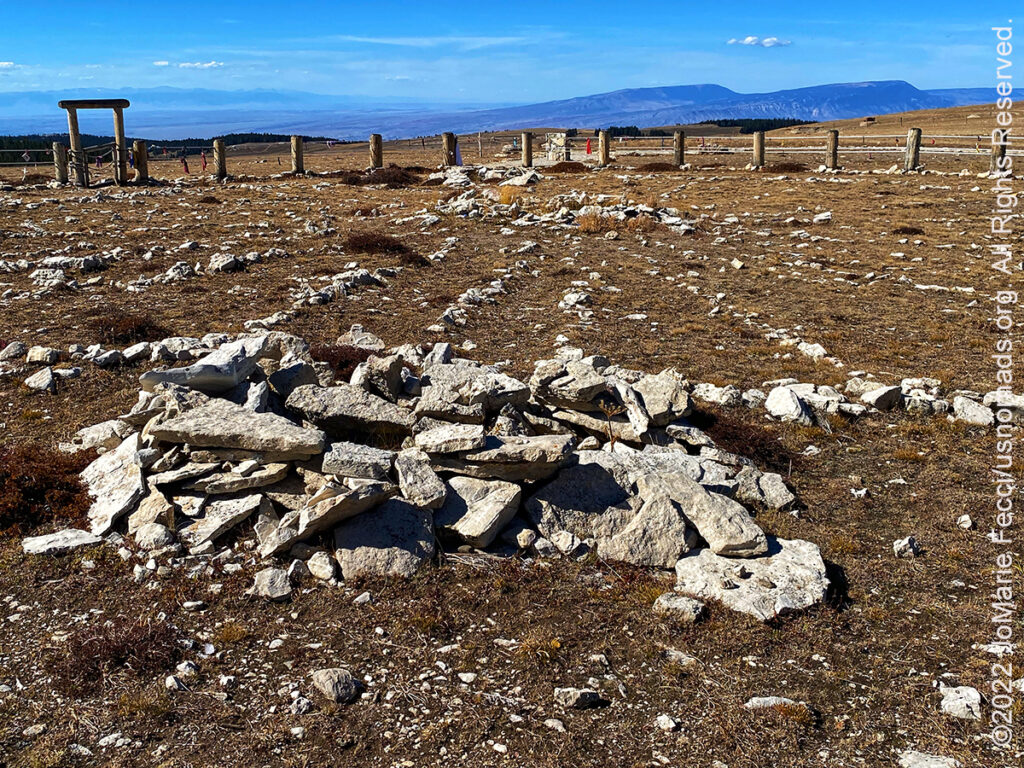
27 September 2022: Enjoyed the drive up into the mountains of the Big Horn National Forest and made a detour to spend some time at the Medicine Wheel National Historic Landmark before descending the mountains and heading for the Big Horn Canyon National Recreation Area. I set up camp at a small campground at a place called Horseshoe Bend (not the famous one on the Colorado River, this one is on the Wyoming/Montana border), and while doing some exploring nearby I found that there were wild horses here — the Pryor Mountain Mustangs. It was late in the afternoon and a good time for seeing wildlife, so I went looking for them and actually DID manage to see a few from a distance …
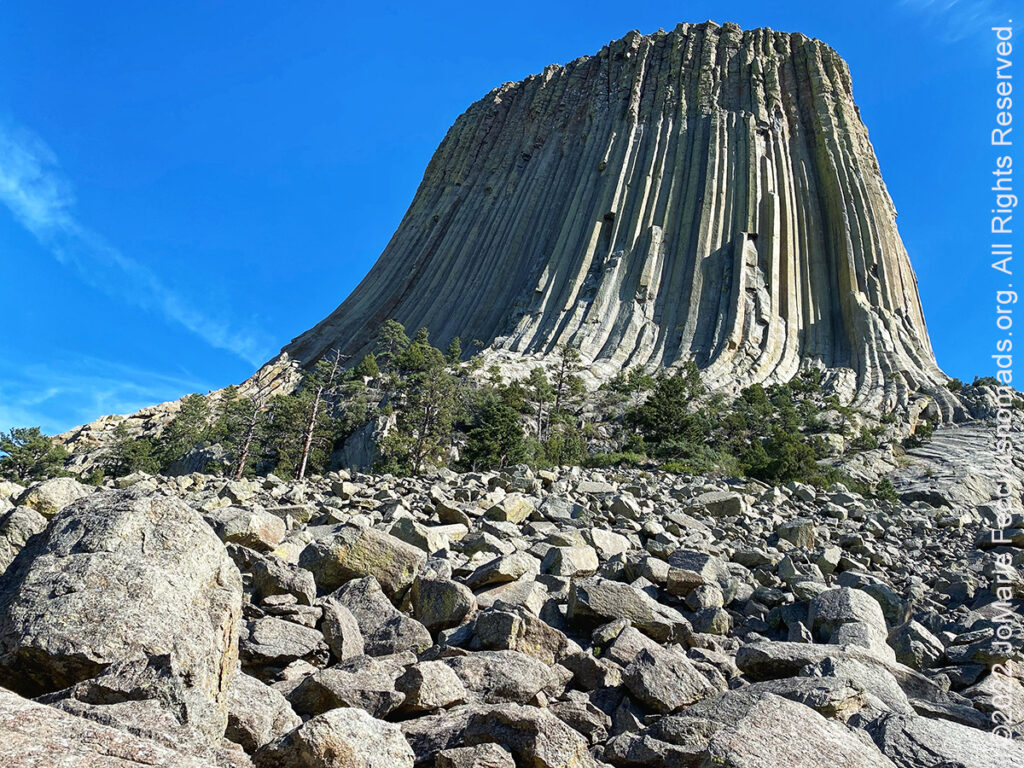
26 September 2022: In the morning I drove through the town of Deadwood, thinking I would stop, but it was one of those “fake” western towns (I mean it was a real town with a real history but it had been disney-fied), so I kept on going. Instead I stopped at the Vorre Buffalo Jump site, and even though there was no one there, I was able to take a walk down into the sink hole and get a sense of the place. From there I continued to the Devils Tower National Monument, which I hadn’t known much about, and learned that it was a sacred place for some indigenous peoples. I respectfully walked clockwise around the massive rock monolith, stopping many times to just take in the enormity of it and reflect quietly. There were many prayer ties fluttering in the wind in different spots. People were climbing the tower as well and they looked so small and insignificant against the enormity of the rock. The hike around the tower took longer than expected because I stopped so much, but I was glad I spent the time like that…
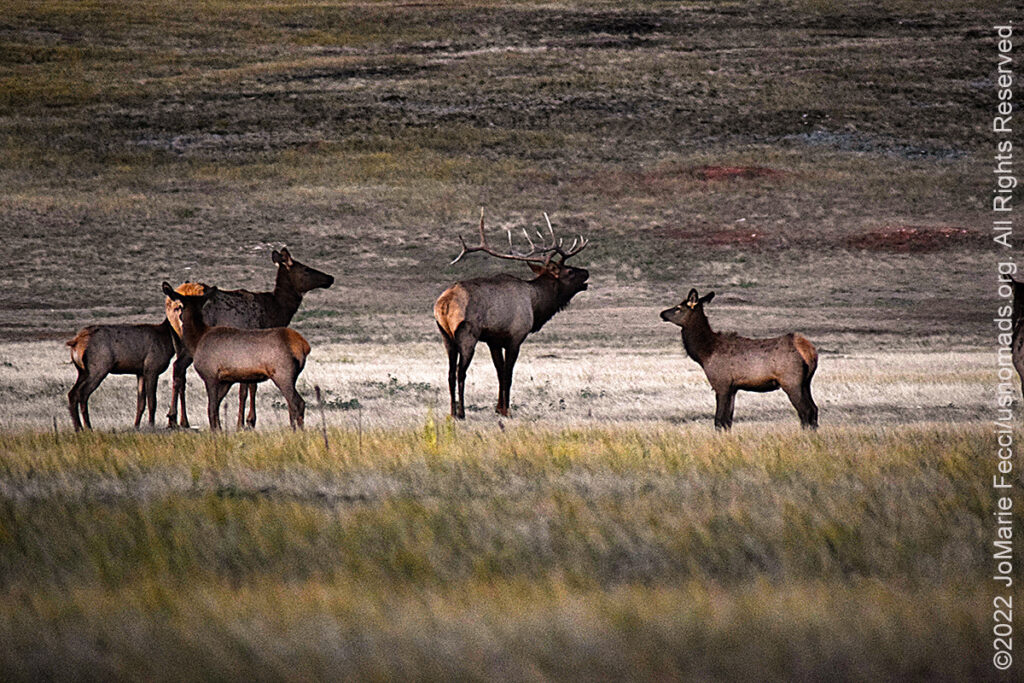
25 September 2022: I woke at first light and decided to go looking for the elk based on where I heard the bugling in the night. I drove in the general direction of where I thought the sound had come from and to my amazement I actually came across a herd of elk — a bull elk, with a large harem, and though there was not yet much light, there was just enough to make a few photos. The elk were far, but they did not run away immediately and the bull bugled some before the herd took off over the hills. Later in the morning I joined the Ranger-led tour of the actual Wind Cave (you can only access it via Ranger tour) and learned about the unique cave and it’s history, then I got back on the road heading to the Black Hills National Forest. Made quick photo stops at the Crazy Horse Memorial and Mount Rushmore along the way…
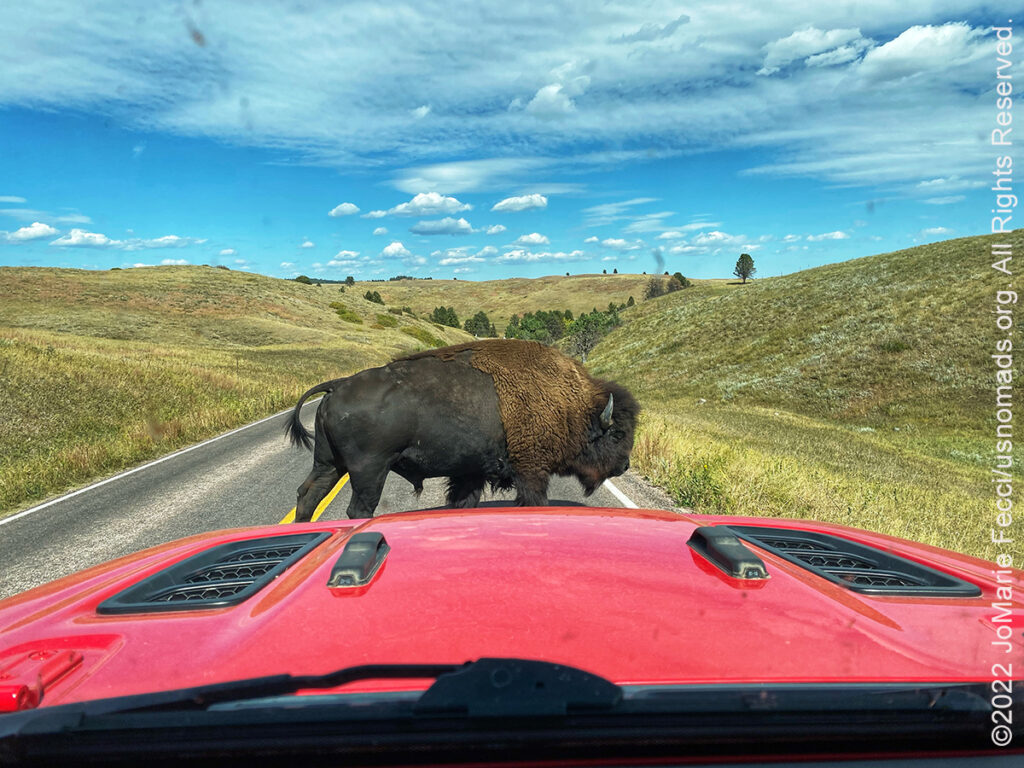
24 September 2022: Packed up camp in the morning amid the buffalo and prairie dogs at Sage Creek, and left Badlands feeling I could have definitely stayed longer — but I needed to keep moving. The drive to Wind Cave was not very long and I had plenty of time to explore the park and locate their buffalo herds which are quite extensive. I also encountered some pronghorn antelopes on the dirt track NPS 5 and saw a coyote at the edge of the woodline near the stream. There were prairie dogs everywhere. I set up my small tent at the Elk Mountain campground and then went to join an evening Ranger Talk where we would listen for Elk Bugling which was actually fun. For the first part of the talk we did not really hear any elk, and so the Ranger had us change locations and eventually we heard some. When I went back to my campsite and made my fire, I sat under the stars and listened and heard quite a bit of bugling. The intermittent bugling continued overnight and I was glad…
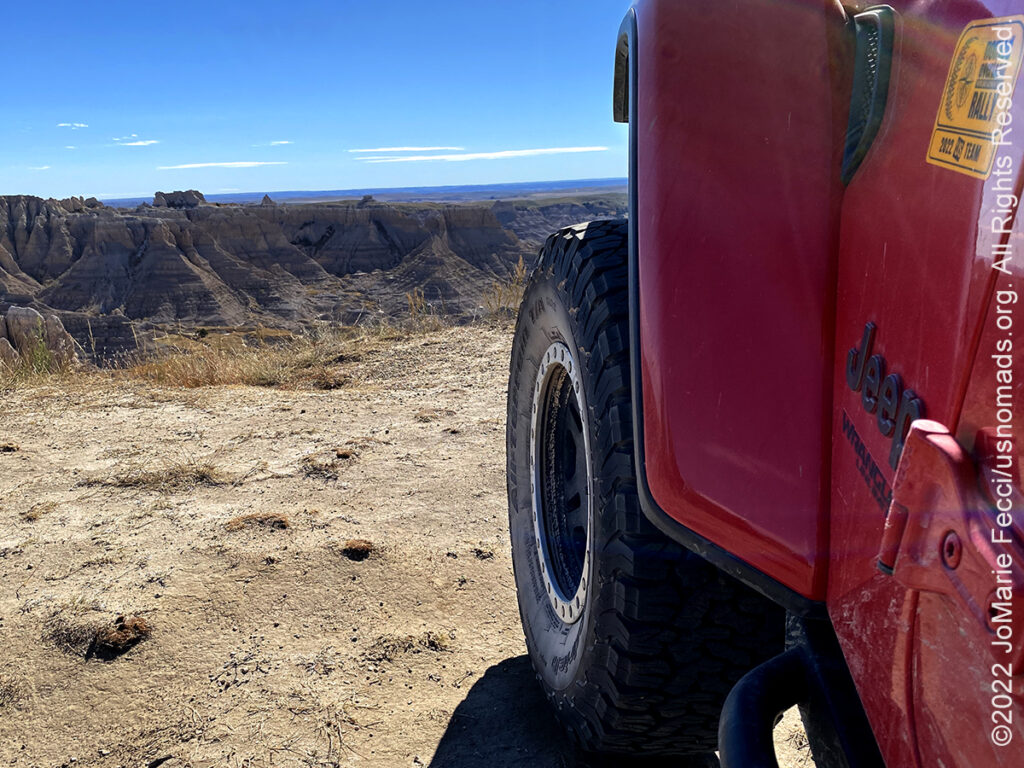
23 September 2022: It was dry and the wind was calmer this morning. I decided to go check out the “South Unit” of the park which is more wilderness and only has one road — a primitive dirt road that goes up a mountain. I took a route through the North Unit of the park that led to more dirt roads and passed a picnic area where the only picnickers were a bunch of buffalo surreal-ly grazing under the picnic shade shelters. There were lots of prairie dog holes along the edge of the dirt roads through private land, then a bit of pavement to get to the South Unit. The sole road through the South Unit is called Sheep Mountain Table Road and the first part of it is a relatively flat washboard road that goes to a beautiful overlook where I stopped for lunch. Beyond that it becomes more of a Jeep trail with many beautiful overlooks on the edge of massive badlands erosion and the best thing about it is that there is no one else on it (at least while I was there), so I could take my time to explore, stop and photograph as much as I wanted. When I came back down I looped back via part of the Buffalo Gap National Grassland where I stopped to play at the Baja ORV area for a little bit before returning to camp for the evening…
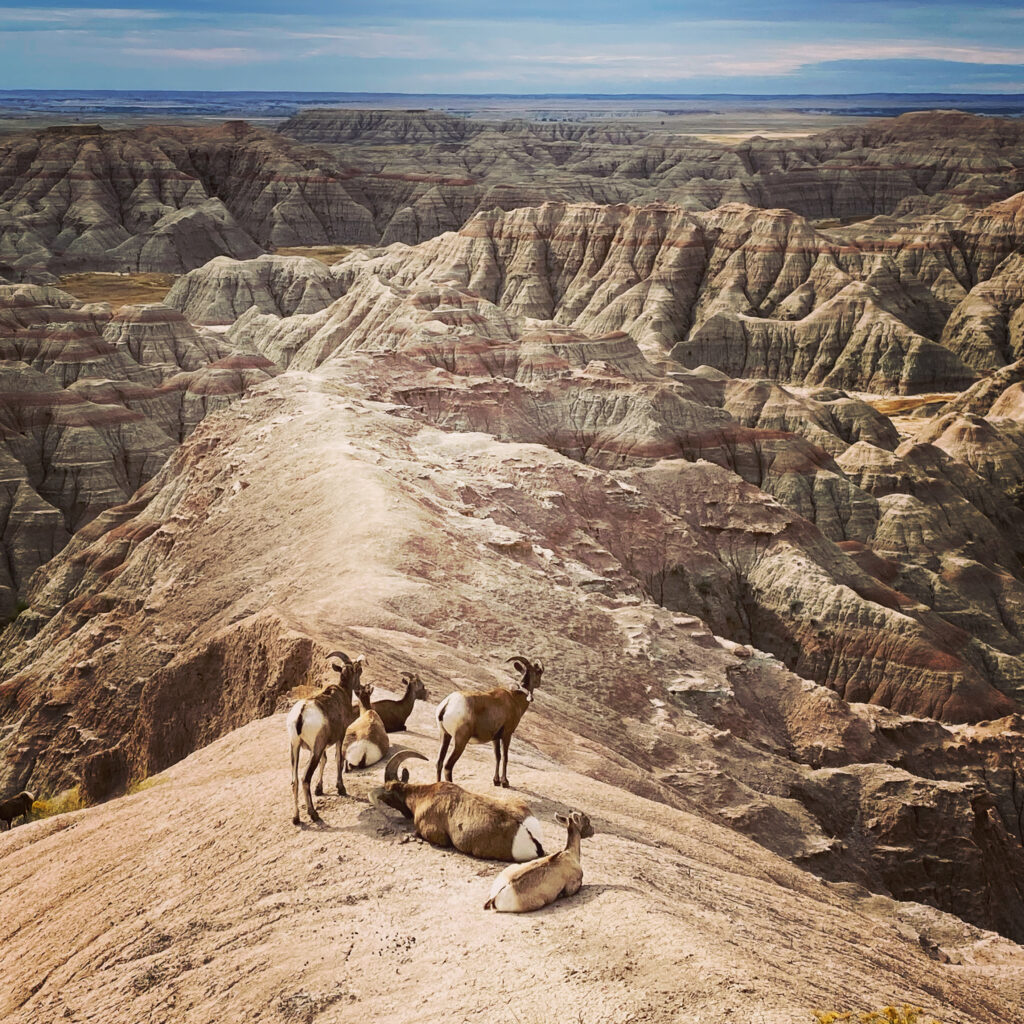
22 September 2022: Up early to get a start on exploring this morning and had amazing luck with wildlife. There were the prairie dogs all around camp, and buffalo wandering around the edges of the campground, but more exciting than that were the big horn sheep that I came across on the heights of the badland landscape. It was such a gift. I drove the Sage Creek Rim Road to the Badlands Loop and made photo stops at numerous overlooks. The weather was spotty and the light was constantly changing. By the time I reached the Visitor Center the wind had picked up and there was a light rain. I decided to go check out the Delta 09 Missile Silo which involved some indoor time watching the film at the Visitor Center before going to see the actual disarmed missile in it’s “hole.” I then looped around to the ghost town of Scenic for some photos before returning to camp where the wind was still strong, but at least the rain stopped …
THIS MONTH:

Fall Roadtrip West, heading from NY to Moab, on the slow road. Taking a different route westbound, with lots of interesting stops along the way. The plan is to go via NY, NJ, PA, OH, MI, WI, MN, SD, WY and UT, camping as much as possible and hitting some key destination locations …
COMING UP SOON:

Attending the Ladies Offroad Network Convention in Moab, UT. The 6th annual convention will be held October 12-15, 2022, with lots of hands-on opportunities to gain all types of offroading skills, learn and engage with other offroad ladies as they share their stories, and laugh the whole way. The convention is an action-packed, interactive 4-day weekend educating, motivating, and guiding offroad ladies…

USnomads.org is very proud to be presenting the second edition of the Nomad Overland Virtual Adventure Rally in 2023. This is a new kind of rally experience — a ten week event that participants can do from anywhere within the continental U.S.A. Competitors design their own routes as part of the rally, then drive it in a points-based online competition that includes optional activity tasks, quests and weekly challenges. The 2023 rally will run from 5 June – 13 August and is open to any driver within the United States who has an off-road capable vehicle — stock or modified. Registration for 2023 is open now. For more information see the Rally website …
REINTRODUCING THE BUFFALO
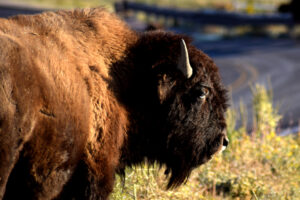
Yellowstone National Park has been at the forefront of the successful restoration of the buffalo in the US. North American “buffalo” are actually “bison” (their scientific name is “Bison bison,” but “buffalo” is used informally — “true” buffalo exist on other continents and are only distant relatives). Early European explorers called the animal by many names, and historians believe that the term “buffalo” grew from the French word for beef, “boeuf.” The American bison once roamed across most of North America in numbers that reached into the tens of millions. Such abundance made the buffalo a critical part of Native American culture: every part of the animal provided something for their way of life. Before horses and gunpowder arrived in North America, native people hunted buffalo on foot. One technique involved stampeding dozens or hundreds of animals off cliffs where they would fall to their deaths. A single “jump” could sustain the members of a tribe for an entire year, providing food as well as materials for clothing, shelter, tools, and more. As European Americans settled the west in the 1800s, the U.S. Army began a campaign to remove Native American tribes from the landscape by taking away their main food source: the buffalo. Hundreds of thousands of bison were killed by U.S. troops and market hunters. By the late 1880s, the great herds that once dominated the landscape were nearly gone. In the Yellowstone area, their numbers dwindled to about two dozen bison that spent winter in Pelican Valley. In one of the first efforts to preserve a wild species through protection and stewardship, Yellowstone’s managers set about recovering the bison population. In 1902, they purchased 21 bison from private owners and raised them in Mammoth and then at the historic Lamar Buffalo Ranch. Eventually, these animals began to mix with the park’s free-roaming population and by 1954, their numbers had grown to roughly 1,300 animals. Today the bison are thriving once again, there are many protected herds on public lands all over the US as well as commercial herds raised as livestock on private ranches, but Yellowstone is the only place in the United States where bison have lived continuously since prehistoric times…
ABOUT WIND CAVE
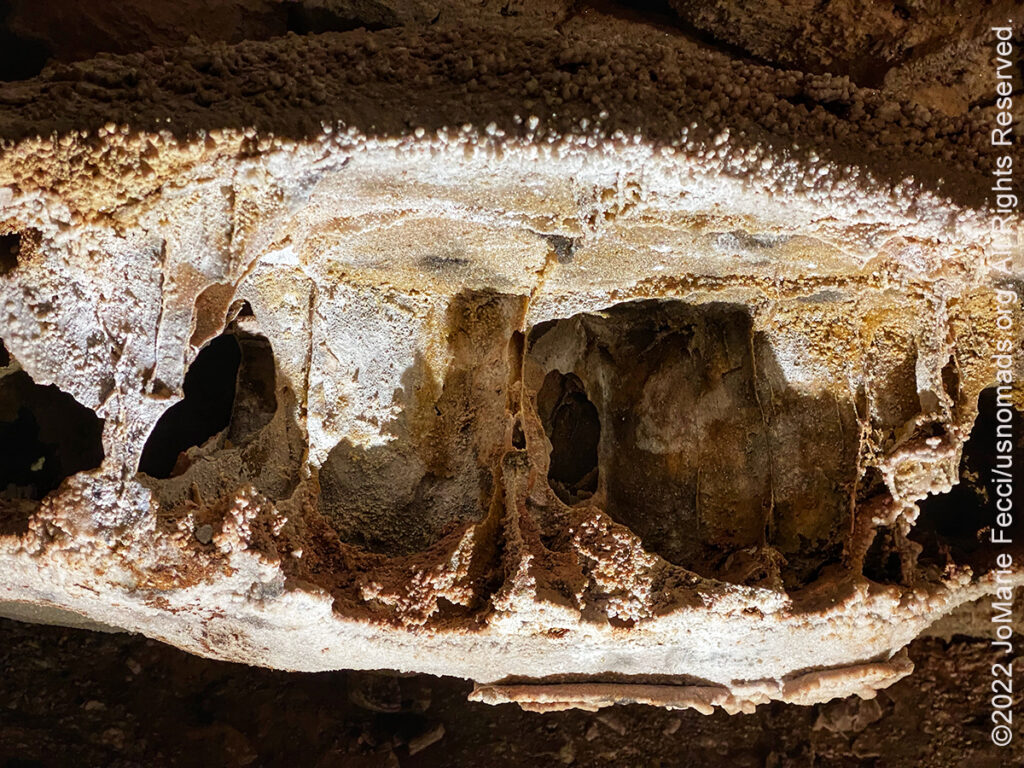
The Wind Cave that the national park is named for is is recognized as the densest cave system in the world, with the greatest passage volume per cubic mile. The passages in the park are said to “breathe” as air continually moves into or out of them, equalizing the atmospheric pressure of the cave and the outside air. When the air pressure is higher outside the cave than inside it, air flows into the cave, raising the cave’s pressure to match the outside pressure. When the air pressure inside the cave is higher than outside it, air flows out of the cave, lowering the air pressure within the cave. The cave is notable for its “boxwork,” an unusual cave formation composed of thin calcite fins resembling honeycombs (approximately 95 percent of the world’s known boxwork formations are found here). The Wind Cave was formed over many millions of years. About 350 million years ago a warm shallow sea covered the area and fragments of seashells, made of calcium carbonate, built up on the seafloor over time, eventually becoming limestone. Bodies of gypsum, made of calcium sulfate, also formed during this time when arid conditions caused seawater to evaporate and the minerals to crystallize. The gypsum formed irregular shaped masses within the limestone. The resulting rock is known as the Madison Limestone formation, or locally as the Pahasapa (Black Hills) Limestone. The gypsum masses were unstable. They grew and shrank as they absorbed and expelled water. This pressure fractured the gypsum and surrounding limestone. Like thick toothpaste, some gypsum squeezed into these cracks and crystallized in place. Later, water rich in carbonate ions converted all of the gypsum to calcite, or calcium carbonate. This set the stage for the cave and boxwork to form. When the oceans receded, it allowed fresh water into the region. This naturally acidic freshwater reacted with the bodies of gypsum. They were converted to calcite, creating sulfuric or sulfurous acid as a byproduct. These acids dissolved the surrounding limestone to form the first cave passageways approximately 320 million years ago. After the first period of cave formation, seas again advanced over this area. About 300 million years ago, layers of red clay, sandstone, and limestone of the Minnelusa Formation were deposited above the Pahasapa Limestone. Some of this sediment washed into and filled early-formed cave passageways near the surface. These reddish “paleofills” are visible in higher levels of the cave, near the Garden of Eden and Fairgrounds rooms. Seas continued to advance and retreat over the area for the next 240 million years. Sediment alternately deposited and eroded from atop the cave. The cave probably developed slowly until the most recent Black Hills uplift between 40 and 60 million years ago. The uplift opened more fractures in the limestone, allowing more cave to form. Water did not flow through the cave like a river. Instead, the water probably sat in the limestone for long periods of time, slowly enlarging small cracks into larger passageways, creating Wind Cave’s complex maze-like pattern. Slow moving water also exposed the boxwork. By dissolving limestone at the edges of the former gypsum masses where expansion had formed cracks, the previously deposited crack fillings now stood in relief. These exposed crystal fins are the “boxwork.” Geologic studies suggest the water began slowly draining from the cave 40 to 50 million years ago. Today the water level is about 500 feet below the surface at an area named “the Lakes.” Water, however, is still changing the cave…
ABOUT THE BADLANDS
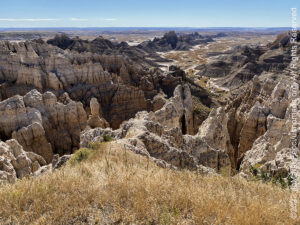
Badlands National Park in southwestern South Dakota protects 242,756 acres of sharply eroded buttes and pinnacles, along with the largest undisturbed mixed grass prairie in the United States. The area around Stronghold Table in the South Unit is revered as a ceremonial sacred site by the Oglala Sioux. At the end of the 19th century, the Sioux used this area as the site of the Ghost Dance, a ceremony to revive the souls of buffalo and the dead. After the last ghost dance in 1890, the United States government banned the ritual. For 11,000 years, Native Americans have had a presence here, beginning with the paleo-Indians, followed by the Arikara people. Archaeological records combined with oral traditions indicate that these people camped in secluded valleys where fresh water and game were available year-round. Eroding out of the stream banks today are the rocks and charcoal of their campfires, as well as the arrowheads and tools they used to butcher bison, rabbits, and other game. By about one hundred and fifty years ago, the Great Sioux Nation consisting of seven bands including the Oglala Lakota, had displaced the other tribes from the northern prairie. The Lakota people were the first to call this place “mako sica”, which translates to — literally — “badlands”. Extreme temperatures, lack of water, and the exposed rugged terrain present many challenges to easy travel. When it rains in the Badlands, the wet clay becomes slick and sticky, making it very difficult to cross. The jagged canyons and buttes that cover the landscape also make it hard to navigate. The winters are cold and windy, the summers are hot and dry, and the few water sources that exist are normally muddy and unsafe to drink. These factors make the land difficult to survive in, and evidence of early human activity in the Badlands points to seasonal hunting rather than permanent habitation. When homesteaders began to move into South Dakota toward the end of the 19th century, the U.S. government attempted to force the Native Americans into reservations. In the fall and early winter of 1890, thousands of Native Americans, including many Oglala Sioux, became followers of the Indian prophet Wovoka. His vision called for the native people to dance the Ghost Dance and wear Ghost shirts, which would be impervious to bullets. Wovoka had predicted that the white man would vanish and their hunting grounds would be restored. One of the last known Ghost Dances was conducted on Stronghold Table in the South Unit of Badlands National Park. As winter closed in, the ghost dancers returned to Pine Ridge Agency. The climax of the struggle came in late December 1890. Headed south from the Cheyenne River, a band of Minneconjou Sioux crossed a pass in the Badlands Wall. Pursued by units of the U.S. Army, they were seeking refuge in the Pine Ridge Reservation. The band, led by Chief Spotted Elk, was finally overtaken by the soldiers near Wounded Knee Creek in the Reservation and ordered to camp there overnight. The troops attempted to disarm Big Foot’s band the next morning. Gunfire erupted. Before it was over, nearly three hundred Indians and thirty soldiers lay dead. The Wounded Knee Massacre was the last major clash between Plains Indians and the U.S. military. Wounded Knee is located approximately 45 miles south of the park on Pine Ridge Reservation. …
MORE NOTES FROM THE ROAD:
16-21 September – Roadtrip West
1-15 September – Long Island
August – Long Island
15-31 July – Serbia
1-14 July – NE Roadtrip
16-30 June – NE Roadtrip
1-15 June – Long Island
May – Nomad Rally Prep
16-30 April – Long Island
7-15 April – Heading Back to NY
1-6 April – Heading Back to NY
27-31 March – Death Valley- DVE
21-26 March – LON Skills Camp
15-20 March – Death Valley
8-14 March – Nevada
1-7 March – Glamis Training
16-28 February – Roadtrip Southwest
1-15 February – Long Island
8-31 January – Long Island
1-7 January – Florida to NY
28-31 December – Okefenokee NWR
24-27 December – Ocala National Forest
19-23 December – Heading South
10-18 December – Long Island
1-9 December – Paris
16-30 November – Paris
1-15 November – Roadtrip East
25-31 October – Roadtrip East
17-24 October – LON Top Ten
7-16 October – Rebelle Rally
1-6 October – Rebelle Training
Archive
SPECIAL REPORT
All about exploring ghost towns and abandoned places in the USA and beyond, with tips, and information on the many different types of sites to be found across the globe, including detailed guides for eight specific sites… [read]
RE-OPENING
Report from the first trail run with the Off Road Consulting group at Rausch Creek Off Road Park as the post-pandemic phased re-openings begin in Pennsylvania and some of our favorite local trails re-open to the public after the two-month shutdown… [read]
REFLECTIONS
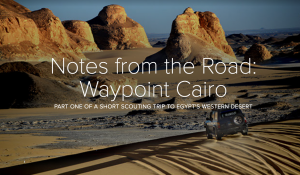
EGYPT: CAIRO REFLECTIONS
A quick overview of impressions from a stop in Cairo during our recent scouting mission in Egypt and Sudan … [read]
SPECIAL REPORT
A look into south-eastern Algeria on the border with Libya and Niger: overlanding with the Tuareg in one of the most remote corners of the Sahara … [read]